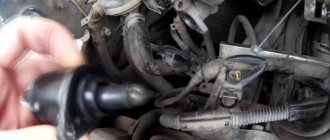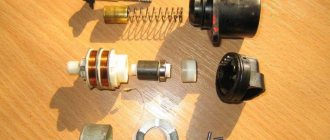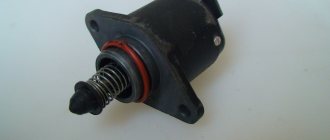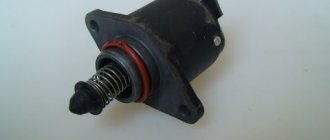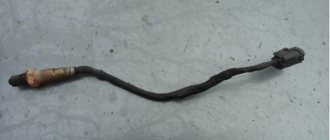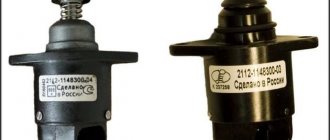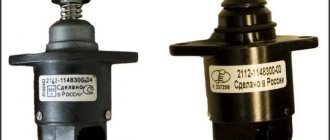The idle air regulator is a special device that regulates the air supply. It is made in the form of a conical valve driven by an electric motor. It is controlled by the ECU, which determines the required channel opening level.
The Niva Chevrolet idle speed control is non-separable, so if problems arise with its operation, it must be completely replaced. Disassembly is somewhat difficult as the throttle body must also be disconnected to remove the regulator.
Procedure for removing the device
To remove this device, you need to stock up on a small set of tools, consisting of a size 13 socket wrench, a screwdriver and pliers.
- Place the car on a level surface and secure it with the parking brake.
- Next you need to disconnect the battery terminals.
- Unscrew the nuts and studs securing the receiver to the throttle valve. In this case, there is no need to disconnect the cooling and crankcase ventilation pipes.
- Disconnect the terminals from the wires.
- Using a Phillips screwdriver, unscrew the vents on the throttle valve.
- Once the device is unscrewed, you can take it out. Usually the O-ring can be removed along with it. But in some cases it may get stuck in the shock absorber.
- In this case, you need to carefully disassemble it.
But sometimes the device may work normally, but malfunctions are due to clogging. In this case, you can try cleaning it with carburetor cleaner. Typically, this method helps to revive a device that has no visible mechanical damage. But this measure does not guarantee 100% results; it is temporary, allowing you to get to the nearest service station or store with spare parts.
The idle speed of the Chevrolet Niva may be adjusted incorrectly if the sensor has a larger stroke between the valve and the supporting surface. When measured with a caliper, this distance should not exceed 23 millimeters.
Compliance with these parameters is necessary for proper installation and not damage to the throttle body.
Cleaning is required before installation. Alternatively, the O-ring can be lubricated with engine oil to facilitate installation.
How does the replacement take place?
The design of the Chevrolet Niva engine allows for replacing the IAC without removing the throttle pipe . This is quite inconvenient, but possible.
Difficulties arise when unscrewing and replacing the rear regulator mounting screw . You have to work with a screwdriver at a certain angle. Therefore, you should not remove the screw after unscrewing; it is better to remove it together with the regulator. The same must be done when installing a new part: first place the screw in its hole and only then install the IAC in the damper body.
Important! We must remember that there is a sealing rubber ring. If, when dismantling a part, it remains in the socket, it must be removed. A new ring is included with the sensor. To avoid damaging it during installation, apply a few drops of clean motor oil to it.
The ability to simply replace the IAC without dismantling unnecessary parts does not mean that you always have to do just that . As a rule, the need for replacement arises after a significant mileage of the car, when the power system is already clogged with all sorts of foreign inclusions, and it is better to combine the work with flushing the throttle.
To do this, the throttle assembly is dismantled as an assembly , after which it is much easier to replace the faulty IAC, and all parts are thoroughly washed, for example, with carburetor cleaner in an aerosol can. A clean throttle will ensure high-quality and uniform engine operation at idle.
When replacing the regulator, you must remove the terminal from the battery . This is not only a safety issue during any work on the engine, but also to ensure normal calibration of the initial position of the IAC rod. Typically, sensors are sold in a cocked state, when the rod is recessed as much as possible. This can be checked by measuring the distance from its cap to the mating flange. It should not be more than 23 mm, otherwise the valve will be pressed into the seat after tightening the fastening screws and damaged.
By connecting the connector to the sensor and replacing the terminal, you can turn on the ignition . The engine control processor will immediately work out the initial position of the rod and ensure normal starting of the motor.
Smooth and stable operation of the engine at idle speed, controlled by a stepper regulator, is very important both for engine life and for traffic safety. A suddenly stalled engine can cause big trouble. Therefore, you should never delay repairs, that is, replacing this simple and inexpensive device.
Even if you manage to avoid undesirable situations on the road, subsequent breakdown and unscheduled engine repairs will cost much more than 500 rubles , which, to a first approximation, a good IAC can cost. The price, of course, is inaccurate, since the production of this device, the original number of which begins with the numbers 21203-1148300, has been mastered by many enterprises.
Accelerator sensor
In addition, the throttle sensor of the Chevrolet Niva can affect the smooth operation of the engine at idle. This component controls the amount of air mixture entering the cylinders. The main task of this part is to make this amount optimal.
The throttle valve is regulated by a special sensor, which, if necessary, closes it, creating a vacuum in the intake system, or opens it, letting in the air mixture.
If there is a malfunction, errors are displayed during the period of inactivity. In this case, you need to remove the element and run diagnostics.
- To de-energize the sensor, you must first disconnect the terminal block
- To check the functionality, you need to measure the voltage between the first and third connectors in the block using a multimeter.
- In this case, it is necessary to change the position of the damper from closed to open.
- The element itself is secured with two screws, which must be unscrewed to replace it.
- After removing the element, make sure that there are no O-rings left in the seat. You need to check its appearance and if everything is fine, reinstall it.
- Now you can install the new part and reassemble it in reverse order.
Where is the Chevrolet Niva located?
As follows from the description of the principle of operation, the regulator is located on the body of the throttle unit of the power system, at the bottom left in the direction of travel . It is located rather inconveniently, which can create problems when replacing it without a certain skill.
The IAC is placed in the housing socket and secured with two screws . Between the regulator and the body there is a sealing rubber ring that prevents air from leaking around the valve.
A clearly visible sector placed on the throttle axis will help you visually locate the regulator . A cable from the accelerator pedal connects to it, which is clearly visible when looking at the engine from above. There are two sensors located on the side of the throttle assembly opposite the cable. The upper one is on the same axis with the cable sector - this is the throttle position sensor (TPS). And the required IAC stands immediately below it, on the same side.
Operating principle of the idle speed sensor
The idle speed sensor, otherwise known as the regulator (IAC), allows you to select the optimal crankshaft speed based on the specified conditions. If this part breaks down, the engine's operating rhythm is disrupted because not enough air enters the combustion chamber.
The principle of operation is as follows: the air flow sensor (DFID) determines how much air has entered the combustion chamber, after which the electronics calculates the amount of fuel that needs to be supplied to the injectors. Engine speed is read from the crankshaft sensor (CSS), and if this sensor is small, the IAC increases the air supply, simulating pressing the accelerator pedal. The system operates in a similar way during a cold start. IAC increases air flow so the engine warms up to optimal temperature faster.
We check the idle speed sensor of the Chevrolet Niva. Replacement with a new one
Most engine control systems are designed in such a way that when the accelerator pedal is pressed and the speed increases, the IAC drive is turned off and remains in its last state before acceleration.
Thus, the load on the regulator drive is reduced. In diesel engines, to maintain idle speed, fuel supply control is also used by bypass type. For this purpose, high-pressure fuel pumps use a special electronic control system.
Solenoid or rotary valves are used as IAC drives in high-pressure fuel pumps. This method makes it difficult to accurately set the idle speed.
Therefore, the valves are controlled by a high-frequency pulse-width modulated signal (PWM modulation). The greater the pulse width, the longer the period of time the idle air control replacement is open, that is, the speed increases. Pulse transistors that control the operation of the valve are often installed in the electronic unit on the fuel pump. Diesel fuel flowing through the pump is used to cool them.
Signs of an IAC malfunction The main signs of a malfunctioning idle air regulator are: Where is the regulator located and its design. The appearance of an IAC with a bypass system is shown in the photo: Sectional view: In some cases, the IAC can be repaired if the winding is broken or the rod is jammed. Disassembly of the regulator should be done with extreme care. In this case, there is no need to disconnect the pipes of the cooling and crankcase ventilation system.
Symptoms of a problem
Most often, an IAC malfunction can be confused with problems that arise when the throttle position sensor fails. The only difference is that when the TPS fails, the CHECK ENGINE indicator on the instrument cluster lights up. If there is an IAC fault, this indicator will not light up.
In addition, a malfunction of the regulator can be determined by several main characteristics:
- When starting the engine, the number of revolutions fluctuates greatly.
- If you turn on the headlights or heater, the speed may drop below 500 rpm.
- When the engine starts after a long period of inactivity, it does not go into heat mode but runs at normal or low speed.
If one or more signs match, then the regulator should be checked. Let's look at the main ways to check the sensor on a Chevrolet Niva:
To check its functionality, you can measure the voltage going to the regulator. Verification steps:
- Place the car on a flat surface and raise the parking brake lever.
- Disconnect the terminals from the controller.
- We take the meter and connect the black wire (minus) to the motor housing, connect the second wire (+) to connectors A and D alternately.
- Turn the key in the ignition and look at the multimeters.
- Normal voltage should be 12 volts. If it is much lower, there is a problem with the battery charge.
- If there is no voltage at all, then there is an open circuit in the circuit going to IAC. In this case, you need to check all the wires going to the sensor and to the computer.
- When checking the resistance, you need to check the IAC terminals one by one: A and B, C and D. If working properly, the resistance should be 53 ohms.
- If you measure the resistance at terminals B and C, A and D, the readings will be above the critical values.
Regulator diagnostics
The functionality of the unit is checked after its dismantling. Before work, turn off the power from the battery and place the car on a flat surface. Dismantling is carried out with the ignition turned off. Disassembly order step by step.
- Remove the power supply.
- Using a 19 mm wrench, remove the two fastening bolts.
- Carefully pull out the regulator.
Connect the power plug to the sensor and turn on the ignition. On a working unit, when the ignition is activated, the rod needle will noticeably move. If the rod remains in place, the element is faulty.
Idle speed regulator Niva, 2121/2123
The Niva car began to be produced back in the days of the Soviet Union and over time has undergone various modifications and improvements. Then the carburetor engine was replaced by a more technologically advanced engine with fuel injection.
As a rule, the operation of an engine with an injector requires a large number of different sensors that automate and simplify the process of working with the internal combustion engine.
Description of IAC
The idle speed control was installed only on the Niva with fuel injection and a mechanical throttle. When installing an electronic accelerator, IAC is not used, since the entire XX process is controlled electronically.
The regulator is designed to adjust engine speed to idle, regulating the air supplied to the cylinder head. The IAC is a DC motor with a worm gear on the shaft that has a cone that regulates the air flow through the XX channel in the throttle assembly.
This sensor is quite unreliable and is often subject to breakdown and replacement. Later, due to unreliability, it was abandoned in favor of an electronic throttle.
IAC device
The idle speed controller is a DC motor. Below is a diagram describing the parts that make up the Niva MAK.
- Mobile air valve;
- IAC overhead mounts;
- Winding;
- Worm gear shaft;
- Output (connector);
- Sleeve;
- Frame.
Where is the sensor located
Adjusting the idle speed of a Chevrolet Niva
The idle air regulator is a special device that regulates the air supply. It is made in the form of a cone-shaped valve, which is driven by an electric motor. The ECU is activated, which determines the required channel opening level.
The Niva Chevrolet idle speed control is non-separable, therefore, if there are problems with its operation, it must be completely replaced. Dismantling is somewhat difficult, since to remove the regulator it is also necessary to disconnect the throttle assembly.
Visual inspection
This check is only performed after removing the IAC from the remote control.
It is necessary to check the condition of the regulator housing. There should be no nicks, cracks or gaps between metal and plastic parts.
The presence of all rivets securing the plastic part of the sensor is checked, since the absence of a rivet may accompany the passage of air.
Check the condition of the rubber o-ring. There should be no marks or cracks on it.
Checking with a multimeter
Since the sensor is mechanical and in principle a conventional DC motor in design, the test is carried out by measuring the resistance of the IAC winding.
To test with a multimeter, set the switch to measure 200 ohms.
We connect the multimeter probes to the central terminals of the IAC and measure the resistance on them. The meter reading on the screen should be close to 50 ohms. If the device displays 1 or infinity, the winding is most likely broken.
If the winding breaks, the idle speed regulator VAZ 2121-2123 must be replaced with a new one.
How to replace IAC on Niva Chevrolet
Before replacing the regulator, you need to find out its catalog number and purchase a spare part with the required article number - 21203114830004. The next stage is the replacement procedure.
Procedure:
- Remove the negative battery terminal.
- Unscrew the fastening of the air pipe to the throttle valve.
- Remove the pipe. If the breather hoses interfere with its dismantling, then they must also be dismantled.
- Remove the cable from the throttle.
- Unscrew the two throttle valve mounting nuts.
- Move it to the side and unscrew the two screws securing the IAC.
- Remove the connector from the regulator and install a new part.
- Reassemble in reverse order.
You can see the replacement procedure in detail in this video:
Is high speed after replacing the regulator normal?
Anyone who has had to replace an idle air control valve has experienced a brief increase in engine speed after starting. This situation is normal, since the new IAC must be “registered”. While the engine ECU does not “know” about the new governor, it increases the speed until the device is reprogrammed. If the situation repeats after each start of the internal combustion engine, initialize the ECU in the diagnostics.
Accelerator sensor
In addition, the Niva Chevrolet throttle sensor can affect the smooth operation of the engine at idle. This component controls the amount of air mixture entering the cylinders. The main task of this part is to make this quantity optimal for high-quality ignition.
The Chevrolet Niva throttle valve is regulated by a special sensor, which, if necessary, closes it, creating a vacuum in the intake system, or opens it, letting in the air mixture.
If the TPS is faulty, faults are displayed during the period of inactivity. In this case, you need to remove the element and carry out diagnostics.
Operating principle of the idle speed sensor.
The idle speed sensor, otherwise known as the regulator (IAC), allows you to select the optimal crankshaft speed based on the specified conditions. If this part breaks down, the engine's operating rhythm is disrupted, since not enough air enters the combustion chamber, as a result of which the engine speed begins to decrease by the floats.
The principle of operation is as follows: the air flow sensor (DFID) determines how much air has entered the combustion chamber, after which the electronics calculates the amount of fuel that needs to be supplied to the injectors. The engine speed is read from the crankshaft sensor (DPKV). The IAC increases the air supply, simulating pressing the accelerator pedal. The system operates in a similar way during a cold start. IAC increases air flow so the engine warms up to optimal temperature faster.
Idle speed controller: causes of malfunctions
The device is a specific relay of a special design. Usually a part fails for a reason.
- Natural wear and tear. With prolonged use, the mechanism can wear out: the spring weakens, the valve head wears out. It is also possible to tear the gasket or sealant.
- Mechanical damage. Typically, such problems arise after careless repairs or improper maintenance of the car. The body of the part is made of plastic and is not designed to withstand shock and strong vibration.
- Electrical damage. Motorists turn to mechanics with the problem of damaged wiring. The malfunction is quickly eliminated and the car is ready to drive again.
- Software failure of electrical equipment. ECU malfunctions and the presence of software errors are included in a separate category. Such problems can only be diagnosed by a scanner and can only be corrected at the software level.
Causes of malfunction and methods of elimination
When troubleshooting, it is not always necessary to replace the idle speed sensor; there may be other reasons that cause failure of the actuator unit.
Oxidized contacts, a broken connector, or a worn wire interrupt the flow of voltage to the actuator. Before disassembling the sensor, the quality of connections of all electrical cables is checked, the battery terminals and connector are cleaned.
In 40% of cases when element failure was diagnosed, the reason was the presence of dirt, dust, or oil particles that clog the movable element of the regulator and stop it. It is necessary to replace the air filter on time and keep the throttle body clean.
Electric motor burnout. This malfunction refers to a direct failure of the sensor, which has a rod and an electric motor in the circuit. You can find the fault by disassembling the sensor into parts and checking it with a multimeter.
Idle speed control
The most common causes of failure of the idle air regulator (IAC) 21203 - 1148300 on the Chevrolet Niva-2123, VAZ 2131 (NIVA) and VAZ-2120 are their modifications.
Symptoms of IACS malfunctions are in many ways similar to TPS (throttle position sensor) malfunctions, but in the latter case, the CHECK ENGINE indicator light clearly indicates a TPS malfunction.”
Malfunctions of the idle speed controller (IAC) 21203 - 1148300 are difficult to identify, since the idle speed sensor on the Chevrolet Niva - 2123, VAZ 2131 (NIVA) and VAZ - 2120 of their modifications is an actuator that is not covered by the general control system, and in case of failures in its operation, the “Check-Engine” warning light does not light up.”
But some characteristic symptoms suggest that the idle speed sensor is not working properly, for example:
— unstable idle speed;
- when the gear shift lever is in neutral, the engine stops involuntarily;
— the minimum decreases significantly when other devices are turned on;
— involuntary increase or decrease in speed, regardless of the engine operating mode;
- When starting a cold engine, it becomes difficult to reach higher speeds.
Any car breakdown requires a timely solution, as it can lead to more serious problems. Sensors in a modern car are one of the most important measuring instruments.
The output of at least one of them leads to the fact that the ECU cannot have a complete picture of the progress of the system.
The sensor cannot be repaired, but if it is dirty, you can try cleaning it with a special carburetor wash. This will not completely solve the problem, but at least it will allow you to get to the nearest garage.
The idle air regulator is a special device that regulates the air supply. It is made in the form of a conical valve driven by an electric motor. It is controlled by the ECU, which determines the required channel opening level.
The Niva Chevrolet idle speed control is non-separable, so if problems arise with its operation, it must be completely replaced. Disassembly is somewhat difficult as the throttle body must also be disconnected to remove the regulator.
Purpose of the regulator
The idle speed sensor on a Chevrolet Niva, as well as for other cars with a gasoline engine and injection system, is considered a part of the fuel supply system. The main purpose of the sensor is to stabilize the air supply when the internal combustion engine is operating at idle speed.
In this operating mode, the throttle valve remains closed; a sensor helps to correctly form the fuel/air percentage ratio, which determines how much air should pass through the intake tract at low speeds.
While the engine is running at medium and low speeds, the DHX additionally stabilizes the operation of the internal combustion engine with a significant increase in voltage from the generator, when the media, fan (stove), lights and other electrical equipment are turned on in the cabin. The idle air control operates to increase the air intake into the cylinders.
To see exactly where the idle speed sensor is located on a Chevrolet Niva, an inexperienced driver needs to study the intake manifold system. Rxx is installed on the throttle block, next to the throttle gate position controller or TPS. The unit resembles a barrel, the mounting flange is adjacent to the body and is fixed, depending on the car model, with 2-3 screws.
Types and designs of idle speed sensor Niva Chevrolet
The standard Chevrolet Niva idle air control is an electromechanical module with a stepper motor and an adjustable shut-off valve. On Shnivy, the model looks like a round plastic cylinder with a terminal for electrical contacts. The device is installed on the carburetor or throttle valve, where it regulates low speed.
The factory model is equipped with a mushroom-shaped plastic shut-off valve. When installing a gas system, some users install the DXX with a metal tip. The reinforced part is more durable and resistant to aggressive environments.
Please note that the device does not have feedback from the ECU. There are only two pairs of contacts in the body of the part, which are responsible for moving the rod and positioning it in space
The cost of the part varies depending on the manufacturer and quality. The original spare part has article number 212031148300-03 and is supplied to the market at a price of approximately 1000 rubles. If desired, you can find a cheaper part, the quantity of which also depends on the manufacturer.
Mostly prices range from 300 to 1000 rubles.
Signs of malfunction of the Chevrolet Niva idle speed control and where it is located
In commonly used terminology, there is always an error in the name of this device, which sets the engine speed when the gas is released, that is, when the throttle valve is completely closed.
It is called a sensor, although, of course, it is not a sensor at all. The Chevrolet Niva idle speed control (IAC), as on all other cars, is an actuator in its principle of operation. Let's consider the reasons for the appearance of this device in the injection control system, the principle of its operation, characteristic signs of malfunctions and methods for finding them. A driver who understands this will be able to independently fix a significant part of the problems in the power system.
